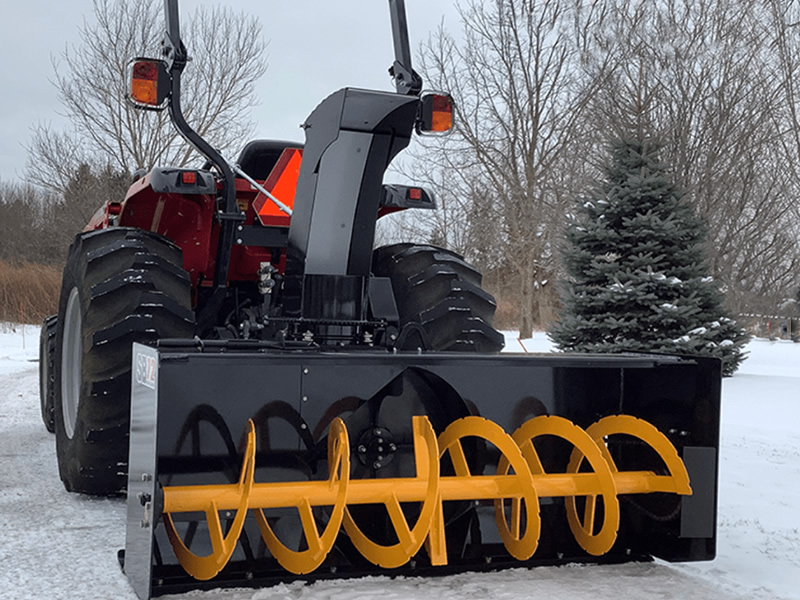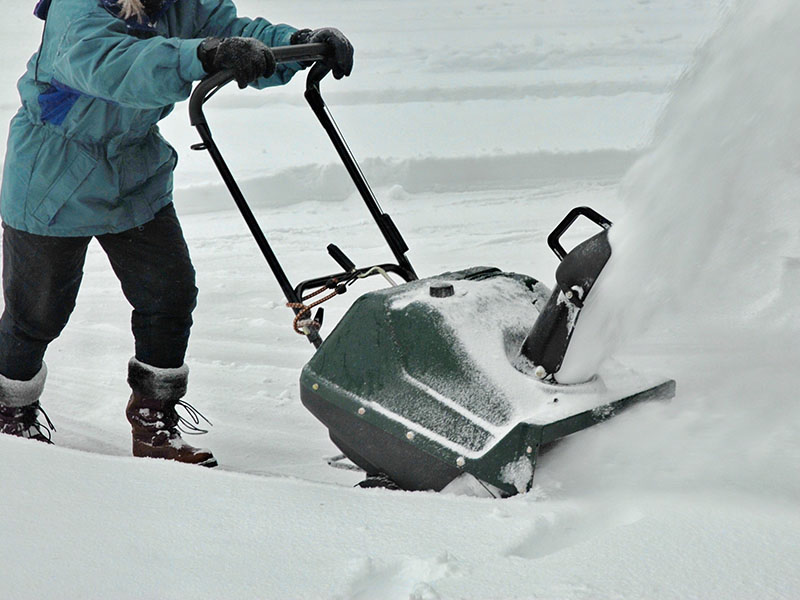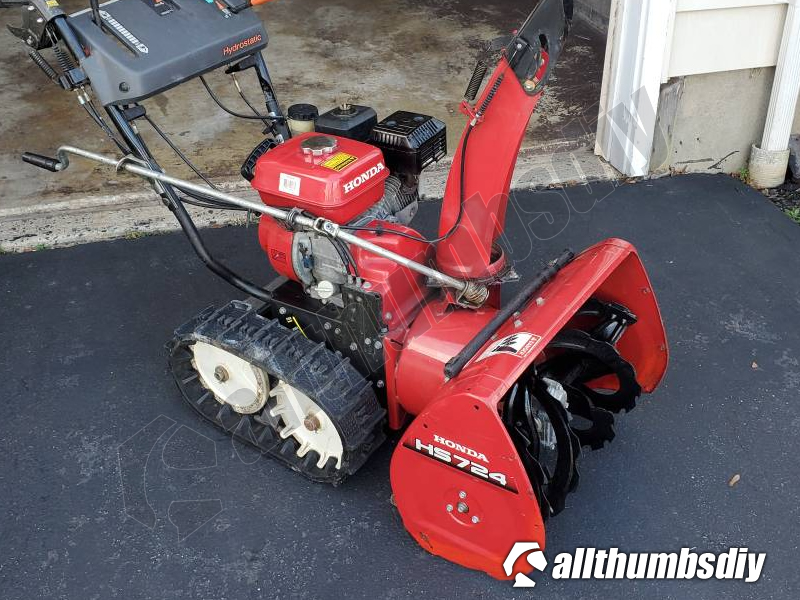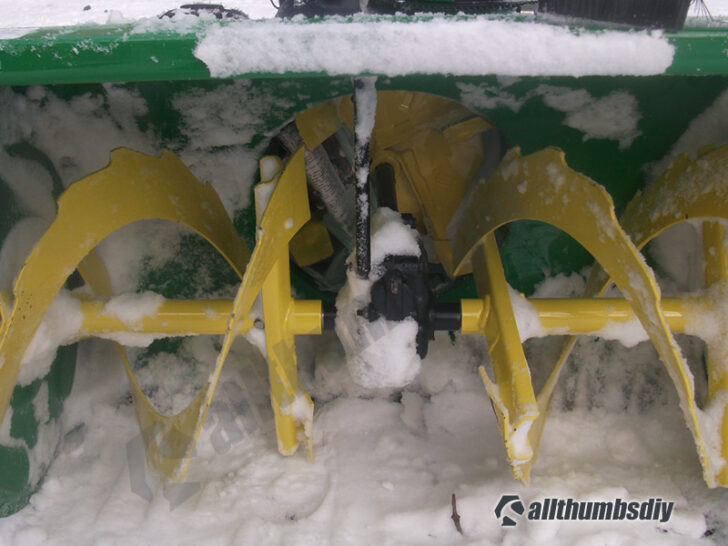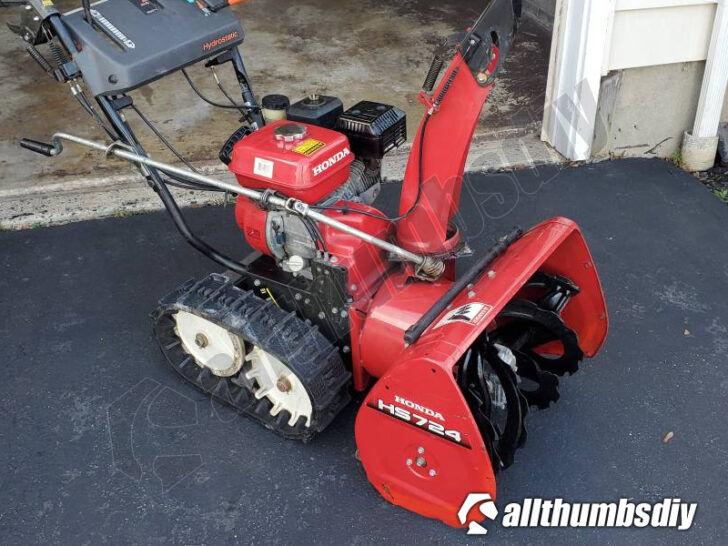Embarking on the journey of selecting a snow blower for your new home involves understanding your specific needs and the machine’s capabilities. It’s important to consider the size of your clearing area, the type of snowfall you typically face, and the snow blower’s power and size to ensure efficient clearing.
Additionally, features like chains for traction and electric starters offer convenience, and understanding basic maintenance will keep your snow blower running smoothly.
As a DIY enthusiast, I learned from personal experience that opting for a larger snowblower than necessary can be a significant misstep. My own purchase of the hefty John Deere 1330SE snow blower taught me this lesson the hard way. It’s important to assess your actual needs before choosing a snowblower’s size. This guide will help you navigate these considerations, ensuring you pick the right tool for your winter needs.
Table of Contents
- Snow Cleaning Needs
- Snow Blower Specifications
- Single, Two, or Three Stage Snowblowers
- Single Stage and Two Stage Impellers
- Augur Design
- Engine Designs
- Starting Mechanism
- Tossing Distance
- Handling
- Weight
- Tires and Spacing
- Chute Control
- Wheel Locking and Differentials
- Tracks vs Wheels
- Chains
- Side Skids
- Where to Throw Snow
- Handle Controls
- One or Two Snow Blowers?
- Maintenance
- Decoding Model Designations
- Prefect Snow Blower for Your Needs
- You May Also Like
Introduction
Choosing the ideal snowblower is about finding a balance between your specific needs and your budget. It’s essential to weigh the trade-offs to ensure you’re not overspending for features you rarely need.
For instance, consider the power and throwing capacity required for your typical snowfall. A 10 horsepower machine throwing snow 45 feet might be overkill for a small area, where a smaller, more affordable model could suffice with a bit of extra effort.
Similarly, a wider 32-inch bucket might seem appealing, but a 24-inch one could be more than adequate for most jobs and easier to store. While a taller 25-inch bucket is great for end-of-driveway piles and drifts, a smaller size might handle most of your needs just fine.
The key is not to let occasional tough spots dictate your choice. Opt for a snowblower that effectively handles your average conditions, accepting that some areas might require a bit more work. This approach ensures you have a practical, cost-effective machine tailored to your regular snow clearing needs.
Just remember that bigger is definitely not better when clearing snow.
Snow Cleaning Needs
When sizing a snow blower, start by assessing your specific clearing needs. Consider the size and layout of your driveway, walkways, and paths. Is your driveway designed for one, two, or three cars? Does it expand near the garage? Also, think about where you can dispose of the snow – can you throw it to both sides, or are you limited to one? The layout of your clearing area greatly influences your choice.
Clearing Area
For a long, narrow driveway, a snow blower with a shorter throw distance is sufficient, as you’ll mainly be moving snow from the center to the sides. However, a wider driveway, especially without side throw areas, may require a larger machine capable of longer throws or even double throws. Double throws can be more challenging, not because of the distance, but due to the compactness of the snow.
Also, consider where the cleared snow will accumulate. Limited space like corners or between structures can quickly fill up after several snowfalls, potentially necessitating a more powerful blower for effective snow disposal.
The dimensions of each area you need to clear matter too. This affects how far you need to throw the snow and what power level is required from the snowblower. Take into account the terrain – is it flat, hilly, or uneven with bumps and crevices? The surface material of your driveway, whether it’s dirt, asphalt, concrete, pebbles, cobblestone, or brick, also plays a role in your choice.
Finally, think about the maneuverability required. A straight, long driveway allows for straightforward clearing with minimal turning. In contrast, a complex driveway with multiple nooks or side areas will demand more frequent chute adjustments, reversing, and turning of the machine. All these factors should guide you in selecting a snowblower that not only fits your budget but also efficiently meets your snow clearing needs.
End of the Driveway Pile
The EOD pile presents a unique challenge. Unlike the snow that blankets your driveway, this accumulation is densely packed, courtesy of passing plows. It’s not just the height of the pile that matters but its density, which often includes heavy, chunky, and sometimes wet snow.
Assess the width of your driveway – is it designed for one, two, or three cars? This factor influences the strength needed in sizing a snowblower to tackle such dense snow. Additionally, if you’re clearing sidewalks that also experience plow buildup, this needs to be considered.
Another important aspect is where the snow will end up. Streets often have a considerable amount of salt mixed with the snow. If you’re planning to throw this snow onto your lawn or flower beds, think about the potential impact of salt on these areas. The choice of your snowblower should be informed by these factors to ensure it can handle the EOD pile effectively while also considering the final destination of the displaced snow.
How much snow
In Eastern Massachusetts, specifically within Route 495, the snowfall pattern typically includes about 3-7 light snows annually, alongside a few heavier storms. Most of the time, you’ll find yourself dealing with 1-4 inches of snow, and occasionally, 6-10 inches. It’s more practical to select a snowblower that suits these average conditions rather than the rare, extreme snowfall. A smaller snowblower can handle larger storms with extra effort and more passes, making it unnecessary to use a 9 to 11 horsepower machine for just 1-3 inches of snow.
The snow in the northern part of the North Shore tends to be heavier than that on the South Shore, and also slightly drier. Consider the typical snowstorms in your area. Close to Boston, and around the 495 belt, the average snow depth and moisture content vary. This affects whether you’re dealing with light, fluffy snow or heavy, wet snow. While a small snowblower can do the job of a larger one, it will require more passes, but this is often manageable for the majority of your clearing area. The end-of-driveway pile is usually the most challenging spot. For a single-car driveway, a small snowblower can be almost as effective as a larger one with a little extra effort. Depending on your region, a smaller snowblower could be a more practical choice.
Remember, while the occasional big storms are memorable, it’s the annual average snowfall that should guide your snowblower selection. Making a choice based on typical conditions, rather than outlier storms, will serve you better in the long run.
Snow Blower Specifications
Snowblowers come in a variety of sizes and configurations, differentiated by factors like horsepower, intake chute width and height, center of gravity, wheel spacing and size, and wheel thickness. Here are some common configurations based on different driveway sizes:
- For Average to Slightly Larger Driveways:
- 5hp: 20 to 24 inches intake width; 12 to 18 inches intake height.
- 6hp: 20 to 24 inches intake width; 12 to 18 inches intake height.
- 7hp: 22 to 26 inches intake width; 14 to 20 inches intake height.
- 8hp: 24 to 32 inches intake width; 16 to 22 inches intake height.
- For Larger Driveways or Multiple Average to Larger Driveways:
- 9hp: 26 to 36 inches intake width; 20 to 24 inches intake height.
- 10hp or more: 26 to 36 inches intake width; 20 to 24 inches intake height.
Each configuration is designed to cater to specific requirements based on the size of the area to be cleared. Smaller driveways can be efficiently managed with lower horsepower and smaller intake sizes, while larger or multiple driveways may require higher horsepower and larger intake dimensions for effective snow clearing.
Evaluating Engine Size and Horsepower Needs
When choosing a snowblower, one critical consideration is the horsepower (hp), which determines the machine’s raw power and snow throwing distance. The size and layout of your area, such as whether you have a long, narrow driveway or a short, wide area, and the ability to throw snow to either side are key factors in deciding the horsepower you need.
Interestingly, there isn’t a significant difference in throwing distance between 5 and 8 horsepower snowblowers. Here’s a rough guide:
- Small areas: 4-7hp; with an intake housing width of 20-24 inches.
- Medium/average driveways: 5-8hp; 22-26 inches intake width.
- Large areas: 6-11hp; 24-28 inches intake width. It’s rare to need a machine over 11hp and 28 inches unless the area is exceptionally large. Remember, most of the time, you’ll use the snowblower for moderate snowfalls, not just the extreme ones.
For shorter throwing distances, a lower horsepower snowblower will suffice, moving snow 10 to 20 feet. An 8hp model can throw snow 15 to 25 feet, but this also depends on snow conditions. Wet, heavy snow typical in early and late seasons, and near coastal areas, is more challenging to throw than the light, fluffy snow of colder days.
Consider the age and condition of the snowblower if buying second-hand. Over time, engines can lose compression and efficiency. While a vintage 1990s model may still work for some, its performance won’t match factory specifications. Read my post, Buying a Rebuilt Snow Blower or Used Snow Blowers – Buying Guide for more information.
Intake Height and Width Dimensions
The size of the snow blower’s intake housing, ranging from 16 to 36 inches, is a critical factor to consider based on your specific clearing needs. For instance, if you have a long, narrow driveway that accommodates one or two cars, think about how many passes you’d need to make with a 20-inch housing compared to a 26-inch one. Ask yourself whether making an extra pass or two is a significant inconvenience for your situation. The width of the intake housing directly impacts whether you’ll need to make multiple passes on walkways or can manage with just one.
Additionally, the height of the snow blower’s bucket is an important consideration. A lower bucket height, around 12 to 16 inches, is suitable for most areas but may struggle with large end-of-driveway (EOD) buildups. You might experience some spillover and need additional passes, but this may not be a major issue if you don’t have a wide driveway entrance or frequent high drifts. In contrast, a bucket height of 16 to 22 inches can more easily tackle larger piles, capturing most of the snow in one go.
Evaluate the typical size of the drifts and EOD piles in your area. Also, consider whether you are clearing a single-car entrance or a wider area, like a three-car driveway. Matching the snow blower’s intake housing size and bucket height to these factors will ensure more efficient and effective snow clearing tailored to your property’s specific needs.
Single, Two, or Three Stage Snowblowers
Snowblowers come in three main varieties, each with distinct features and capabilities: single-stage, two-stage, and three-stage models.
Single-Stage Snowblowers
These machines have one set of intake blades that scoop up the snow and directly throw it out through a chute. They are particularly effective for lighter snowfalls and smaller areas but tend to struggle with larger, heavier snow.
Single-stage snowblowers are often self-propelled, with the blades lightly touching the ground, meaning they don’t have a separate wheel drive. Traditionally, these models mostly featured two-stroke engines, but there’s a growing shift towards four-stroke engines in newer designs.
Two-Stage Snowblowers
These are more robust, designed to collect snow with an initial auger and then pass it to a separate impeller, which ejects the snow at a greater distance. This design allows them to handle both light and heavy snow efficiently.
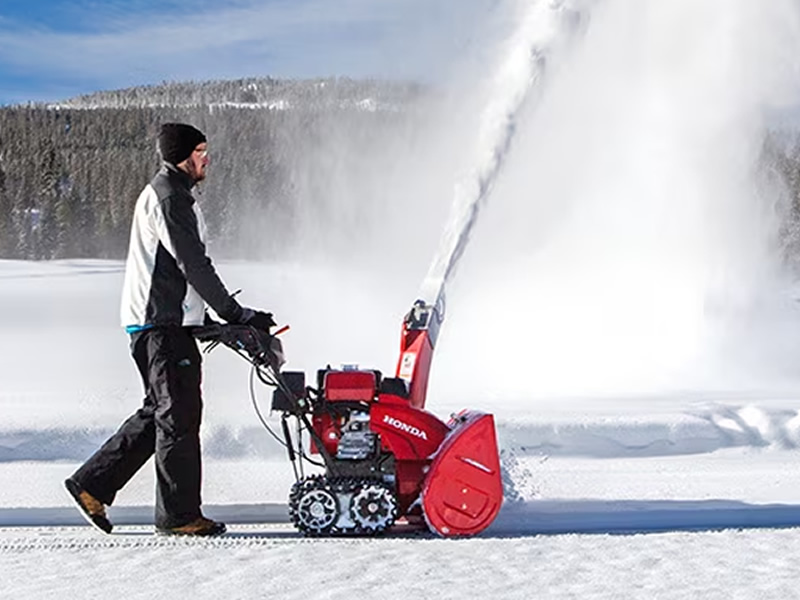
Two-stage snowblowers typically come with driven wheels, offering better traction and control, especially in deeper snow. They are generally equipped with four-stroke engines, providing more power and efficiency.
Three-Stage Snowblowers
Expanding on the two-stage design, three-stage snowblowers incorporate an additional auger, known as an accelerator, which helps break down and move heavy, wet snow to the impeller more quickly and efficiently.
This makes them particularly effective for clearing large snowfalls and dense snow piles. Like two-stage models, they have driven wheels and usually feature powerful four-stroke engines.
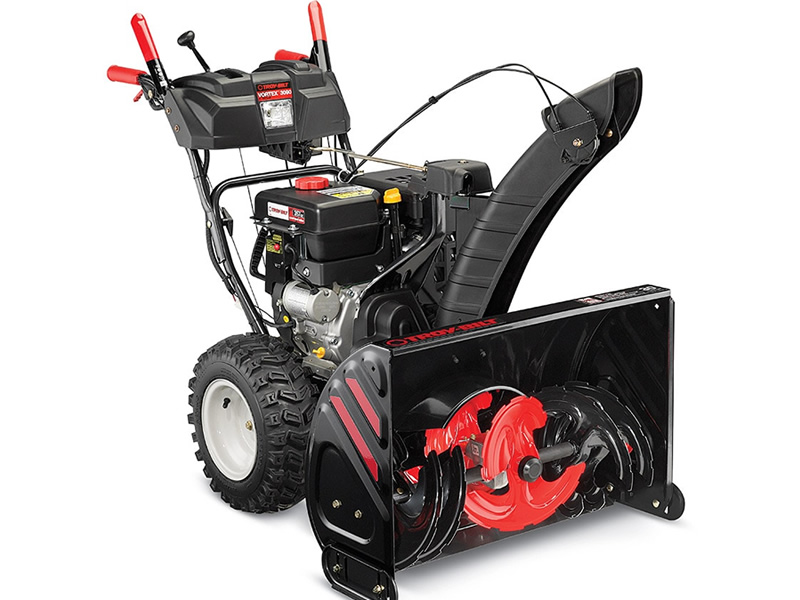
Three-stage snowblowers are ideal for those who regularly deal with challenging, heavy snow conditions and need a machine that can clear large areas quickly.
Each type of snowblower offers different benefits, with single-stage models being more suitable for light snow and smaller areas, two-stage models offering versatility for various snow conditions, and three-stage models providing maximum efficiency in heavy and challenging snowfall scenarios.
Single Stage and Two Stage Impellers
The impeller in a two-stage snowblower, consisting of 3 to 4 blades of varying shapes around the auger drive shaft, plays a crucial role in snow clearing. As the augers push snow into the impeller, which typically rotates at about 1200 rpm, the impeller’s blades, varying from flat paddles to long strips, effectively eject the snow. The diameter of these impellers ranges from 10 to 14 inches, with larger diameter impellers generally found in higher horsepower models, often featuring four blades for maximum efficiency. This design contrasts with single-stage snowblowers, where there’s no separate impeller. Instead, single-stage models use a thin metal auger with rubber tips to directly throw snow out through the chute. The auger’s shape is flat near the center, facilitating this direct ejection. These machines operate at higher speeds than their two-stage counterparts to compensate for the lack of an impeller, achieving the necessary momentum to throw snow effectively. Additionally, single-stage snowblowers lack wheel drive; the rubber auger tips make contact with the ground, propelling the machine forward, though they may bounce on uneven surfaces, like non-flat driveways.
Augur Design
In snowblowers, the design of the auger and impeller varies between two-stage and single-stage types.
In a two-stage snowblower, the auger blades are mounted on a sleeve or, in some designs like Toro’s, on a large cylinder attached to the auger drive shaft. This design, especially the larger drum, helps prevent clogging as it moves snow towards the impeller.
In contrast, single-stage snowblowers feature a center part of the auger that doubles as the impeller. These models typically have rubber auger blades mounted on a metal auger, similar to their two-stage counterparts.
However, unlike two-stage models where the blades deliver snow into a separate impeller and do not extend across the entire intake housing, single-stage augers run the full width of the intake housing.
They have a flattened section near the center, right under the chute, which effectively propels snow up into the chute for ejection.
Engine Designs
In the realm of snowblower engines, the traditional choice has been L-head (flat head) engines, with Tecumseh L-heads being a standard for over 40 years.
However, there’s a growing shift towards overhead valve (OHV) engines. The differences between these two types are subtle for average home machines, and both are generally suitable. OHV engines offer some advantages, such as better fuel efficiency, enhanced durability, quieter operation, and slightly more torque compared to a similar L-head horsepower rating.
While L-head engines have no significant drawbacks, the benefits of OHV engines make them an appealing choice. Although Tecumseh, a long-time leader in L-head engines, is no longer in business, their parts remain readily available.
Nowadays, Briggs and Stratton, along with various Chinese manufacturers, are common providers of both L-head and OHV engines for snowblowers.
Two and four stroke engines
When it comes to the distinction between one-stroke and two-stroke engines, the main difference lies in their oil and fuel management.
Two-stroke engines mix oil and gas together, eliminating the need for oil changes. Four-stroke engines, on the other hand, have a separate oil reservoir and require periodic oil changes.
These changes are typically straightforward, involving a spout at the engine base and usually require just one quart of oil. Both engine types have their own merits and can be selected based on personal preference and maintenance comfort.
Starting Mechanism
Electric start on snowblowers, though a convenient feature, often remains underutilized.
Most well-maintained snowblowers will readily start with the first or second pull, relegating electric start to a backup role. The requirement of a plug-in line cord for electric starters sometimes makes it more hassle than it’s worth, especially when compared to the simplicity of manually pulling the starter rope.
This ease of starting is further facilitated by the design of snowblowers, which, unlike lawnmowers, do not have an air filter. The carburetor throat is open, a design choice made feasible by the absence of dust and dirt in snowy conditions.
Snowblowers are equipped with primers and chokes, ensuring gas flows into the carburetor for easy starting. With careful use of clean gas, a snowblower should start within the first 1 to 3 pulls. Regular maintenance and care further ensure that the snowblower remains easy to start for many years.
For those who have difficulty with manual starting or encounter a hard-to-start machine, electric start proves invaluable. It can be particularly helpful when dealing with issues like carburetor, choke, or primer problems, muscling through these challenges and saving the day.
Despite its convenience in these scenarios, the reality is that if your snowblower doesn’t start within the first few pulls, it often indicates an underlying issue that needs addressing.
Proper maintenance ensures that your snowblower remains reliable, minimizing the need to depend on the electric start feature.
Tossing Distance
Tossing distance is a key specification listed by manufacturers for each snowblower model, though it’s important to note that these figures are often based on ideal conditions, which may not frequently occur.
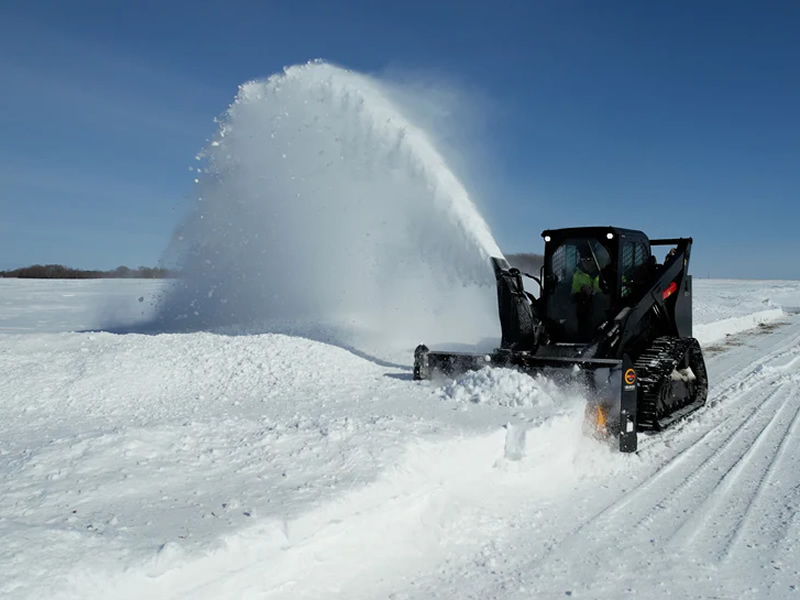
The primary factor influencing throwing distance, apart from the ever-important condition of the snow, is the machine’s power.
While both horsepower and torque play roles, torque is particularly crucial. For practical purposes, we can assume that higher horsepower typically means more torque.
A new snowblower operating at its peak can see a 5hp model nearly matching the distance of an 8hp under certain conditions. However, the relevance of maximum tossing distance varies depending on your specific snow removal needs.
For some, there may be parts of their area where throwing distance is critical. In such cases, you might manage with a shorter distance by taking smaller cuts or opting for double throwing in certain sections.
| If your driveway layout allows you to clear snow from the center and throw it to both sides, you might not need a snowblower with exceptional throwing distance, unless your driveway is unusually wide. In summary, your specific snow clearing needs and the physical layout of your property should guide your choice in terms of horsepower and snow throwing capability. |
For instance, a robust 5hp snowblower, which can approximate an 8hp in some scenarios, may not match the 8hp in terms of power when dealing with a drift or heavy end-of-driveway snow, but by reducing the intake cut, it could still be sufficient.
Larger snowblowers typically boast more horsepower (and consequently more torque), as well as larger diameter impellers, leading to a higher rotational speed and, therefore, a greater throwing distance.
Impeller sizes in snowblowers range from 10 to 16 inches in diameter, which contributes to their varying capabilities in snow tossing. Ultimately, selecting a snowblower with the appropriate power and tossing distance depends on assessing your typical snow clearing requirements and balancing them with the machine’s specifications.
For more detailed information, read my post Snow Throwing – How to Get the Maximum Distance.
Handling
Snowblower design, particularly the tractor section and engine placement, significantly affects its performance and ease of use. Models that are lower to the ground, with engines centered over the wheels, tend to handle differently and dig into the snow in distinct ways.
The width and height of the handles also play a role, impacting how comfortably you can maneuver the machine.
Consider the layout of the areas you’ll be clearing: the frequency of turns needed with your snowblower will vary based on the shape and size of your driveway or pathways. For a long, narrow driveway, fewer turns are needed, whereas a short, wide area demands more frequent maneuvering.
When planning your snow clearing strategy, think about the amount of turning involved and choose a model that suits these needs.
Executing turns with a snowblower can range from straightforward moving turns to more challenging U-turns, which might require lifting the handles to pivot the machine. If lifting is difficult for you, consider creating a larger turning area at the end of each pass or clearing a small section specifically for turning. This approach allows for easier driving turns, which are simpler and quicker to execute once mastered.
The ease of turning can be enhanced by features like wheel locks and differentials. However, the surrounding environment often dictates turning ease.
For example, turning into uncleared snow, even with advanced wheel features, can be challenging. In some cases, locking both wheels for better traction in drifts and end-of-driveway (EOD) piles might be more beneficial than setting the wheels for easier turning.
Those with pin-lock differentials often choose a setting that best suits their needs and leave it there, as changing it during clearing can be inconvenient. Generally, having both wheels locked for enhanced traction is more advantageous than setting them for easy turning.
Ultimately, the decision on which setting to use depends on your physical capabilities and the specific conditions of your clearing area. Balancing the ease of maneuverability with the need for effective snow removal is key when selecting and operating your snowblower.
Weight
The weight of snowblowers, typically ranging from about 150 to 250 pounds, presents both advantages and challenges. In heavy snow conditions, a more robust machine has the benefit of better traction and digging capability, as its heft helps it to effectively penetrate and move through dense snow.
However, in lighter snowfalls, the same weight can become a hindrance, making the machine cumbersome to maneuver.
The design of the intake housing also plays a role. A lighter housing may tend to ride up when dealing with heavy loads, while a heavier, solid steel bucket will continue to dig into end-of-driveway (EOD) piles and drifts for longer periods.
The balance of the snowblower, whether evenly distributed over the wheels or tilted forward, also affects handling. For example, some Toro models feature a mechanism that shifts the weight forward, enhancing pavement contact but potentially leading to increased wear on the machine. While effective, this can be seen as overkill and tough on the snowblower’s parts.
A practical approach is to take smaller cuts when dealing with heavy snow, thereby reducing strain on the machine. The size and heft of the snowblower should be considered in relation to your specific clearing area. It’s important to remember that most snowfalls are moderate and EOD piles relatively manageable. Thus, choosing a snowblower that performs well in average conditions, even if it means a bit more effort during severe snowfalls, can be a sensible trade-off, balancing efficiency in typical scenarios with the capability to handle more challenging snow events.
Tires and Spacing
When considering the technical aspects of snowblower wheels, both size and spacing play pivotal roles in the machine’s overall performance and handling. Large, widely spaced tires are often preferred for their ease of maneuverability and turning. They elevate the height of the tractor section, which, while beneficial in some aspects, can lead to the intake housing riding up prematurely in certain snow conditions.
On the other hand, smaller wheels that are positioned closer to the housing offer different advantages. Though they may be somewhat more challenging to turn, they generally provide better traction and are more effective at driving into snow piles. However, due to their reduced width, these smaller wheels often benefit from the addition of chains to enhance grip, especially in icy or particularly dense snow conditions.
Wheel tread is another important factor. Wide wheels with a robust tread pattern can significantly improve handling and stability, particularly in varied snow conditions. The tread design influences the snowblower’s ability to maintain traction, preventing slippage and ensuring a steady clearing process.
In summary, the choice of wheel size and spacing should be guided by the specific snow clearing needs and the typical conditions of your area. Larger, wider wheels offer ease of movement and are suitable for less compact snow, while smaller, closely-spaced wheels with added chains are better suited for tackling dense, heavy snow and achieving deeper penetration into snow piles. Balancing these factors with a suitable tread pattern will ensure optimal performance and ease of use of your snowblower.
Chute Control
The positioning and design of chute controls on snowblowers can significantly affect ease of use, especially in specific clearing situations.
Controls located low and to the side are adequate for scenarios with minimal changes and longer runs, whereas top dash-mounted controls offer convenience for those who need to make frequent turns or adjustments on the move.
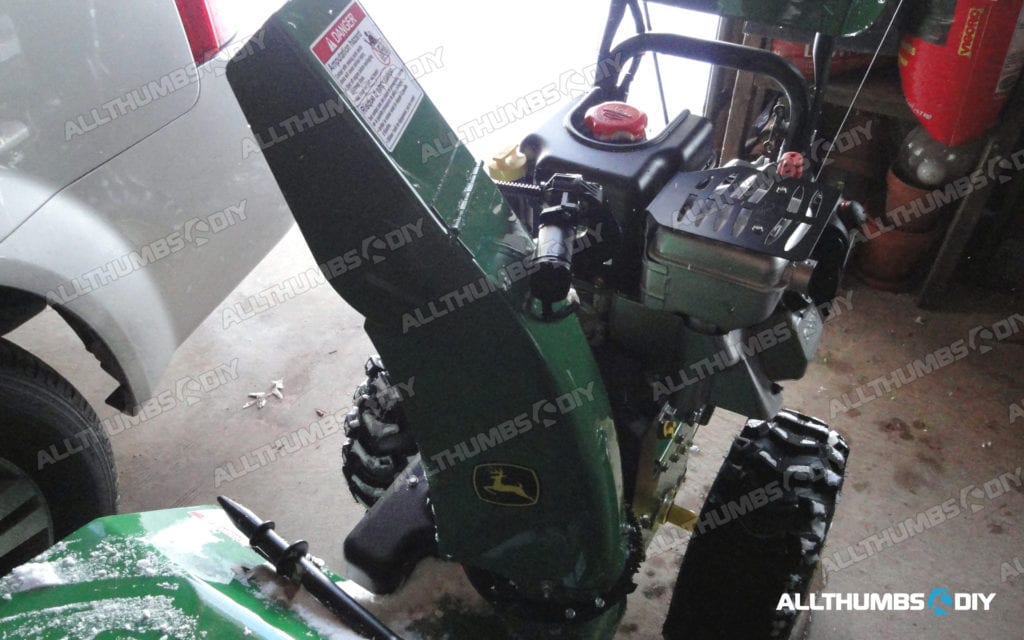
The feel and type of control also play a role; many snowblowers, like those from Murray and MTD, use a spiral mechanism at the end of the control rod that fits into notches in the chute. While this design is cost-effective and durable, it can be somewhat imprecise. In contrast, fully mechanical gears and linkages offer more precise control and tend to move less under the heavy vibration common in snowblowers.
Most blowers feature a top chute handle for easy adjustment of the snow’s discharge direction. Some models include a remote top chute control on the dash, which is handy when maintained with occasional oiling.
However, these can be prone to sticking or freezing if not properly cared for, potentially causing inconvenience. Electronic chute controls, while technologically advanced, introduce an additional point of potential failure. For many users, manually turning a crank to adjust the chute is a simple and reliable method.
The choice between a top dash-mounted control and a lower side mount depends largely on the frequency of chute movement required during clearing. A top dash control offers ease of use for frequent adjustments, while a lower side mount suffices for less complex operations.
Wheel Locking and Differentials
Understanding and choosing the right wheel control system can greatly enhance your snow blowing experience, offering a balance between ease of maneuverability and effective snow clearing.
Whether opting for a simple wheel lock or a more sophisticated wheel differential, these features play a crucial role in how comfortably and efficiently you can manage your snowblower.
Most wheeled snowblowers offer two types of wheel control systems:
Wheel Lock
This is a mechanical system that allows one wheel to be disengaged from the drive shaft, facilitating easier turning. It operates via a pin that, when inserted through both the hub and the drive shaft, locks the wheel to the drive shaft, causing it to turn together.
If the pin is inserted only through the drive shaft, the wheel can turn freely. This setup makes the snowblower easier to turn, as one wheel is driven while the other is free.
However, changing these pins while snow blowing is often too cumbersome, leading many users to set it once for the season and leave it.
Wheel Differential (WD)
WD system allows either wheel to be disengaged for more effortless turning. Some WDs are automatic, while others are manually controlled via triggers located under the handlebars.
This feature enables one wheel to slip from the drive, making turning more straightforward. Full differentials, like those on Ariens machines, are particularly efficient and can be easily adjusted even while wearing gloves during snow blowing.
The ability to lock in or out with handlebar triggers is becoming more common and is a convenient feature, though it can be more expensive. However, its necessity diminishes as users become more adept at controlling their snowblower, especially if a full differential system is already in place.
Tracks vs Wheels
Track systems, resembling those found on tanks, excel in traversing hills and slopes but present challenges when attempting sharp U-turns. Some snowblowers equipped with tracks offer the option to disengage individual tracks to facilitate powered turning, as seen in Honda and MTD machines.
Honda and MTD’s track-equipped snowblowers are known for their durability, with a lifespan spanning many years. While track machines may have a steeper learning curve, they prove valuable even in predominantly flat terrains.
However, they may not be the ideal choice for areas necessitating frequent tight turns and reverse maneuvers. Notably, MTD models stand out as an exception due to their ease of handling, making them a versatile choice for various snow-clearing tasks.”
Chains
The necessity of chains on snowblower tires largely depends on the specific conditions of the area being cleared. Older models, with the exception of Toro, often featured small tires with limited grip, making chains a more essential accessory.
However, modern snowblowers are generally equipped with larger tires that boast aggressive, knobby tread patterns, providing substantial grip on both flat surfaces and mild inclines, and thus reducing the need for chains in many scenarios.
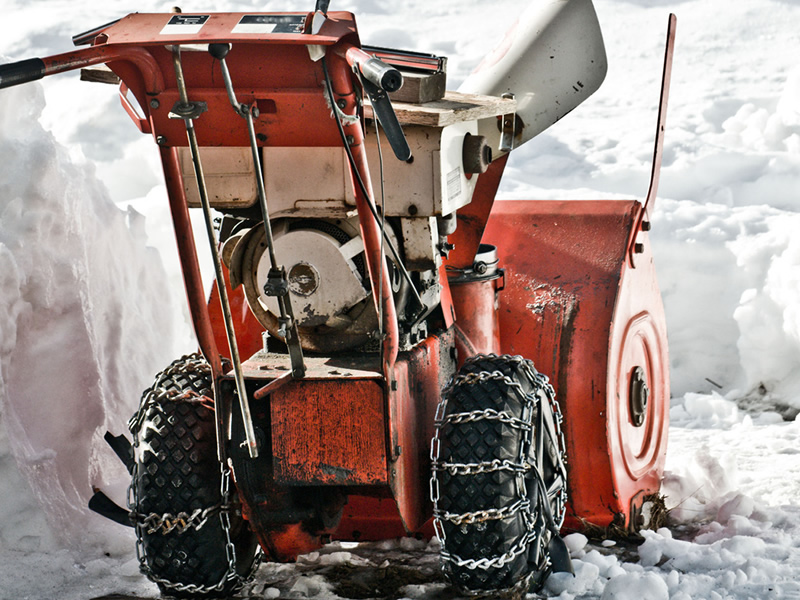
Chains on snowblower tires aren’t solely beneficial for maintaining grip on slopes; they also assist the tractor in driving into heavy snow piles.
However, in areas with primarily flat terrain, the advanced tread design of modern snowblower tires usually suffices, eliminating the necessity for chains. It’s worth noting that chains can be noisy and may cause damage to tar driveways or lawns.
Snowblowers come with multiple speed settings, and often a simple adjustment to a lower speed can enhance grip in situations where chains might otherwise be used. In areas without significant snow buildup, chains may not provide a notable advantage.
Additionally, if you experience loss of wheel grip while using a 24-inch bucket, opting for a narrower cut can help maintain traction without the need for chains.
You can check out the generic snow blower tire chains here.
Side Skids
Skids function as the protective shoes of a snowblower, located at the bottom of the intake housing and adjustable via two bolts.
Adjusting these skids alters the height at which the intake housing rides: extending the skids raises the housing, while retracting them allows the housing to come closer to the ground.
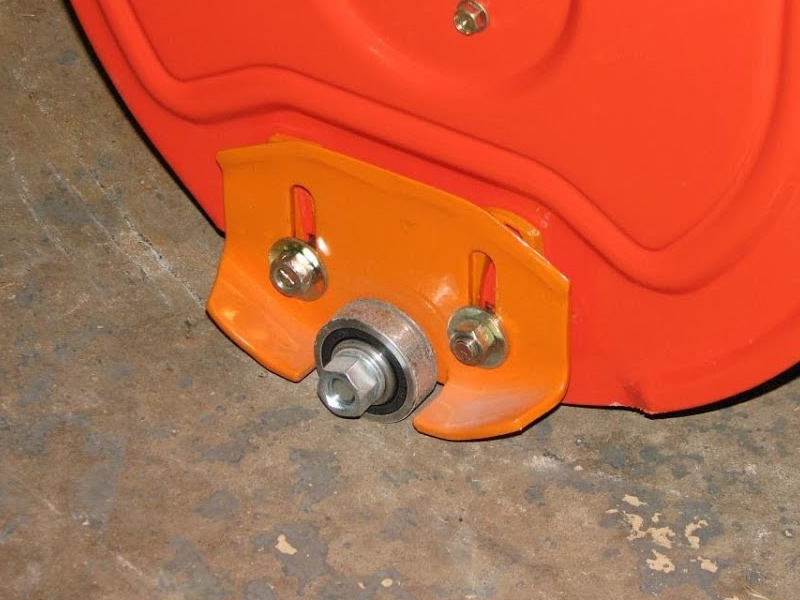
The actual contact with the ground is made by a replaceable component called the scraper bar, designed to endure wear and tear and to be replaced when necessary.
Proper skid adjustment is crucial depending on the surface you’re clearing. On gravel or dirt driveways, setting the skids to raise the housing about an inch off the ground helps prevent rocks and gravel from being scooped up, which could jam the augers and damage the intake housing and impeller.
However, setting the skids too high may result in a thin layer of snow left behind, as the scraper and augers won’t be close enough to the ground.
For those with flat, smooth surfaces like cement or pavement, it’s common to adjust the skids so the scraper just grazes the surface. This setting ensures minimal snow is left on the ground, which can be easily cleared by the sun later.
Maintenance of the skid bolts is also important; they can rust, so brushing them off after use and applying a drop of oil during the season can prolong their lifespan and ensure smooth operation.
Where to Throw Snow
When using a snowblower, it’s important to consider the impact of salt, especially if you live in an area where streets and sidewalks are heavily salted. Clearing snow from the end of your driveway (EOD) or sidewalks means you might inadvertently transfer a significant amount of salt to areas where you dispose of the snow. For instance, if you have a flower border on your front lawn and habitually throw snow there, you could be depositing large amounts of salt onto your flower beds.
Furthermore, repeatedly throwing snow to your neighbor’s yard can lead to issues, especially if you keep dumping road salt contaminated snow onto their garden. Don’t be that jerk. Throw snow onto your property.
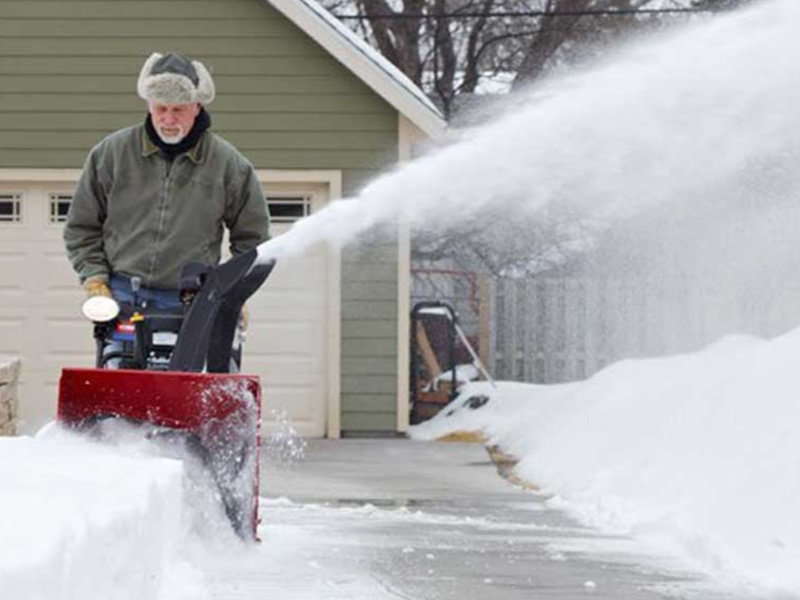
It’s also crucial to plan your snow clearing strategy based on your driveway’s layout. Consider whether you can throw snow to both sides of the driveway, or if you need to start from one side and throw across one or two car lengths.
Alternatively, starting in the middle and throwing to either side can be an efficient method. Assess the longest distance you’ll need to throw snow under average conditions. Depending on your specific situation, you might find that a smaller snowblower, which requires double throwing occasionally, is more suitable than a larger, more powerful model that’s only necessary a few times each year.
This approach not only addresses your immediate snow clearing needs but also considers the long-term effects on your property and landscaping.
Handle Controls
Handle controls on snowblowers typically feature levers for engaging the auger and activating the tractor drive. These controls often include safety mechanisms, such as automatic shutoffs that activate if the auger control is engaged without simultaneously lifting the drive lever.
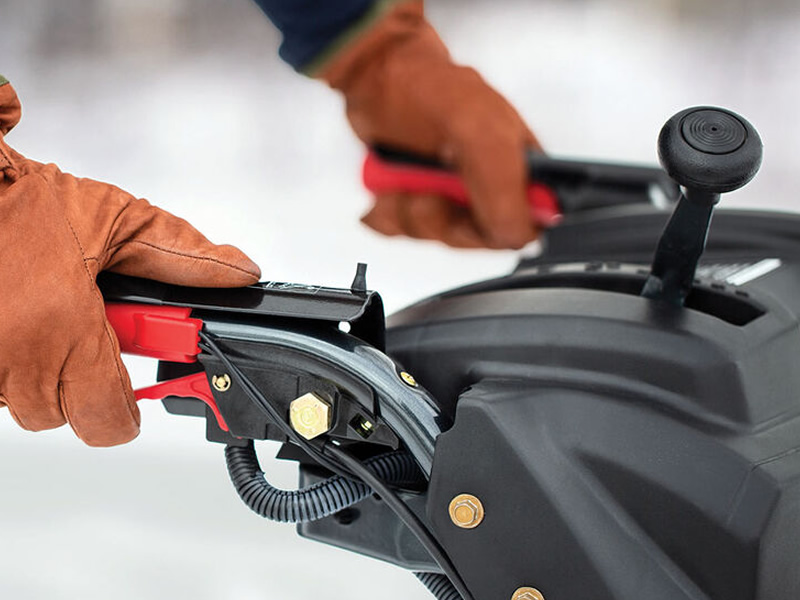
In most modern models, the design has evolved to include a feature that allows the auger lever to lock in conjunction with the drive lever.
This advancement is particularly user-friendly as it frees up one hand, making it easier to operate the chute control while the machine is in motion. Such ergonomic designs enhance the user experience by simplifying the operation and improving safety features.
One or Two Snow Blowers?
It’s not uncommon for individuals to own two snowblowers – a larger primary one and a smaller, lighter backup unit. This combination often consists of a main two-stage snowblower for handling heavier snowfalls, paired with a smaller single-stage model that’s ideal for lighter snow, slush, and quick clear-ups.
The convenience of having a small single-stage snowblower on hand can be incredibly beneficial, offering flexibility and ease of use for a variety of snow conditions. This approach ensures that you’re well-prepared for anything the winter weather might bring, with each machine serving a specific and valuable purpose in your snow-clearing arsenal.
Maintenance
Maintaining a snowblower is relatively straightforward but crucial for preventing premature malfunctions and issues. Adequate upkeep ensures your snowblower remains reliable and efficient over time.
If you’re not familiar with or willing to perform basic maintenance tasks, like those typically required for a lawnmower, then owning a snowblower might not be the best choice.
For detailed guidance on snowblower maintenance, please refer to the dedicated maintenance page. It’s important to understand that regular maintenance is key to the longevity and optimal performance of your snowblower.
Decoding Model Designations
Understanding the model designations of snowblowers can be quite straightforward once you know what to look for. Typically, model numbers indicate essential features like horsepower and cutting width.
For instance, a model numbered 521 usually means it has 5 horsepower and a 21-inch wide cutting path. Similarly, 622 would represent a 6 horsepower engine with a 22-inch cut, and 824 would be an 8 horsepower machine with a 24-inch wide cut.
Beyond these practical designations, snowblowers often come with marketing names, which are more about branding than specification.
Examples include the Toro XL, Toro Powershifter, Ariens SnoThro, and YardMachine. It’s important to note that these names don’t specifically identify a snowblower’s features and can be used for a range of models over many years. For example, the general model ‘Toro 521’ has seen various iterations and changes over a span of more than 20 years.
For precise identification, particularly when ordering parts or manuals, you should refer to the factory model number. This number, always a sequence of digits, provides specific information about the make and features of the snowblower.
Often times, you will have to separately search for your snow thrower’s engine service manual.
You can typically find the factory model number on a tag located on the lower base at the back of the machine. This number is the key to accurately identifying your snowblower’s exact specifications and requirements.
Prefect Snow Blower for Your Needs
In selecting the ideal snowblower, it’s crucial to consider both your typical snowfall patterns and budgetary constraints, aiming for a practical balance between functionality, convenience, and cost.
Most regions experience snowfalls ranging from one to four inches annually, with only occasional heavier snows. Therefore, opting for a snowblower that is sized for these average conditions is generally the most sensible approach.
While larger models may seem attractive for handling heavy 10-inch storms, they can be unnecessarily cumbersome for lighter snowfalls. C
onversely, smaller machines, although requiring extra passes in heavier snow, are more cost-effective, easier to handle, and simpler to store, making them a practical choice for most scenarios.
Additional features like hand warmers, lights, wheel differentials, and electric chute controls may be indispensable for some, akin to an apple peeler for those who need it, yet superfluous for others. These features, while enhancing ease of use, should be weighed against their potential for added complexity and failure points.
Remember, the majority of snow clearing tasks can be efficiently managed with simpler mechanisms like a hand crank chute control.
Ultimately, the perfect snowblower is one that meets your regular clearing needs without overextending on rarely used capabilities or features. It’s about making informed trade-offs, focusing on what you’ll encounter most of the time, rather than being swayed by occasional extreme conditions.

